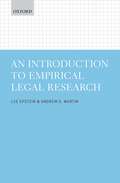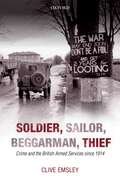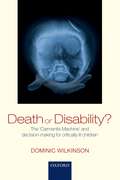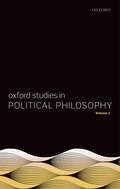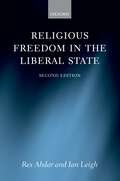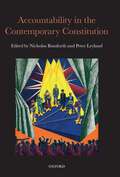- Table View
- List View
When Humans Become Migrants: Study of the European Court of Human Rights with an Inter-American Counterpoint
by Marie-Bénédicte DembourThe treatment of migrants is one of the most challenging issues that human rights, as a political philosophy, faces today. It has increasingly become a contentious issue for many governments and international organizations around the world. The controversies surrounding immigration can lead to practices at odds with the ethical message embodied in the concept of human rights, and the notion of 'migrants' as a group which should be treated in a distinct manner. This book examines the way in which two institutions tasked with ensuring the protection of human rights, the European Court of Human Rights and Inter-American Court of Human Rights, treat claims lodged by migrants. It combines legal, sociological, and historical analysis to show that the two courts were the product of different backgrounds, which led to differing attitudes towards migrants in their founding texts, and that these differences were reinforced in their developing case law. The book assesses the case law of both courts in detail to argue that they approach migrant cases from fundamentally different perspectives. It asserts that the European Court of Human Rights treats migrants first as aliens, and then, but only as a second step in its reasoning, as human beings. By contrast, the Inter-American Court of Human Rights approaches migrants first as human beings, and secondly as foreigners (if they are). Dembour argues therefore that the Inter-American Court of Human Rights takes a fundamentally more human rights-driven approach to this issue. The book shows how these trends formed at the courts, and assesses whether their approaches have changed over time. It also assesses in detail the issue of the detention of irregular migrants. Ultimately it analyses whether the divergence in the case law of the two courts is likely to continue, or whether they could potentially adopt a more unified practice.
When Humans Become Migrants: Study of the European Court of Human Rights with an Inter-American Counterpoint
by Marie-Bénédicte DembourThe treatment of migrants is one of the most challenging issues that human rights, as a political philosophy, faces today. It has increasingly become a contentious issue for many governments and international organizations around the world. The controversies surrounding immigration can lead to practices at odds with the ethical message embodied in the concept of human rights, and the notion of 'migrants' as a group which should be treated in a distinct manner. This book examines the way in which two institutions tasked with ensuring the protection of human rights, the European Court of Human Rights and Inter-American Court of Human Rights, treat claims lodged by migrants. It combines legal, sociological, and historical analysis to show that the two courts were the product of different backgrounds, which led to differing attitudes towards migrants in their founding texts, and that these differences were reinforced in their developing case law. The book assesses the case law of both courts in detail to argue that they approach migrant cases from fundamentally different perspectives. It asserts that the European Court of Human Rights treats migrants first as aliens, and then, but only as a second step in its reasoning, as human beings. By contrast, the Inter-American Court of Human Rights approaches migrants first as human beings, and secondly as foreigners (if they are). Dembour argues therefore that the Inter-American Court of Human Rights takes a fundamentally more human rights-driven approach to this issue. The book shows how these trends formed at the courts, and assesses whether their approaches have changed over time. It also assesses in detail the issue of the detention of irregular migrants. Ultimately it analyses whether the divergence in the case law of the two courts is likely to continue, or whether they could potentially adopt a more unified practice.
Explaining Criminal Careers: Implications for Justice Policy (Clarendon Studies in Criminology)
by John F. MacLeod Peter Grove David FarringtonThis is an open access title available under the terms of a CC BY-NC-ND 3.0 International licence. It is free to read at Oxford Scholarship Online and offered as a free PDF download from OUP and selected open access locations. Explaining Criminal Careers presents a simple but influential theory of crime, conviction and reconviction. The assumptions of the theory are derived directly from a detailed analysis of cohort samples extracted from the Home Office Offenders Index - a unique database which contains records of all criminal (standard list) convictions in England and Wales since 1963. In particular, the theory explains the well-known Age/Crime curve. Based on the idea that there are only three types of offenders, who commit crimes at either high or low (constant) rates and have either a high or low (constant) risk of reoffending, this simple theory makes exact quantitative predictions about criminal careers and age-crime curves. Purely from the birth-rate over the second part of the 20th century, the theory accurately predicts (to within 2%) the prison population contingent on a given sentencing policy. The theory also suggests that increasing the probability of conviction after each offence is the most effective way of reducing crime, although there is a role for treatment programmes for some offenders. The authors indicate that crime is influenced by the operation of the Criminal Justice System and that offenders do not 'grow out' of crime as commonly supposed; they are persuaded to stop or decide to stop after (repeated) convictions, with a certain fraction of offenders desisting after each conviction. Simply imprisoning offenders will not reduce crime either by individual deterrence or by incapacitation. With comprehensive explanations of the formulae used and complete mathematical appendices allowing for individual interpretations and further development of the theory, Explaining Criminal Careers represents an innovative and meticulous investigation into criminal activity and the influences behind it. With clear policy implications and a wealth of original and significant discussions, this book marks a ground-breaking chapter in the criminological debate surrounding criminal careers.
International Migration Law
by Vincent ChetailInternational Migration Law provides a detailed and comprehensive overview of the international legal framework applicable to the movement of persons across borders. The role of international law in this field is complex, and often ambiguous: there is no single source for the international law governing migration. The current framework is scattered throughout a wide array of rules belonging to numerous fields of international law, including refugee law, human rights law, humanitarian law, labour law, trade law, maritime law, criminal law, and consular law. This textbook therefore cuts through this complexity by clearly demonstrating what the current international law is, and assessing how it operates. The book offers a unique and comprehensive mapping of this growing field of international law. It brings together and critically analyses the disparate conventional, customary, and soft law on a broad variety of issues, such as irregular migration, human trafficking, refugee protection, labour migration, non-discrimination, regional free movement schemes, and global migration governance. It also offers a particular focus on important groups of migrants, namely migrant workers, refugees, and smuggled migrants. It maps the current status of the law governing their movement, providing a thorough critical analysis of the various stands of international law which apply to them, suggesting how the law may continue to develop in the future. This book provides the perfect introduction to all aspects of migration and international law.
International Migration Law (International Law Ser.)
by Vincent ChetailInternational Migration Law provides a detailed and comprehensive overview of the international legal framework applicable to the movement of persons across borders. The role of international law in this field is complex, and often ambiguous: there is no single source for the international law governing migration. The current framework is scattered throughout a wide array of rules belonging to numerous fields of international law, including refugee law, human rights law, humanitarian law, labour law, trade law, maritime law, criminal law, and consular law. This textbook therefore cuts through this complexity by clearly demonstrating what the current international law is, and assessing how it operates. The book offers a unique and comprehensive mapping of this growing field of international law. It brings together and critically analyses the disparate conventional, customary, and soft law on a broad variety of issues, such as irregular migration, human trafficking, refugee protection, labour migration, non-discrimination, regional free movement schemes, and global migration governance. It also offers a particular focus on important groups of migrants, namely migrant workers, refugees, and smuggled migrants. It maps the current status of the law governing their movement, providing a thorough critical analysis of the various stands of international law which apply to them, suggesting how the law may continue to develop in the future. This book provides the perfect introduction to all aspects of migration and international law.
Treatment of Contracts in Insolvency (Oxford International & Comparative Insolvency Law)
This is the second title in the new Oxford International and Comparative Insolvency Law Series. Virtually any insolvency needs to deal with the matter of contractual obligations and this book focuses on the extent to which insolvency law interferes with those obligations and relationships. As with the first volume in the series, the topic is addressed through national reports from nineteen of the main economically developed countries, all of which follow a uniform structure. This format enables easy comparison between the jurisdictions and substantially enhances the accessibility of material on a jurisdiction to foreign lawyers. It is essential for all commercial lawyers to consider the implications of insolvency (whether of their client or of the counter-party) on any contract that is under discussion, particularly where there are international aspects to the transaction. This work provides authoritative guidance on the consequences of insolvency on the contractual relationship covering issues such as performance, rights of counterparties, and the special treatment of specific contracts. Also considered are the effects of pre-insolvency negotiated contractual remedies such as flip clauses, automatic termination, acceleration clauses, close out netting provisions, flawed/conditional rights and penalty provisions. There is also guidance given on striking a balance between competing interests in an insolvency situation, for example social concerns raised by some employment contracts. Quality, uniformity and the high level of detail of National Reports are the key benefits of this book. The topic of the treatment of contracts is one in which there are significant differences internationally making this volume a valuable reference tool for practitioners, scholars, and postgraduate students alike.
Family Law: A Very Short Introduction (Very Short Introductions)
by Jonathan HerringWhat is a family? What makes someone a parent? What rights should children have? Family Law: A Very Short Introduction gives the reader an insight not only into what the law is, but why it is the way it is. It examines how laws have had to respond to social changes in family life, from rapidly rising divorce rates to surrogate mothers, and gives insight into family courts which are required to deal with the chaos of family life and often struggle to keep up-to-date with the social and scientific changes which affect it. It also looks to the future: what will families look like in the years ahead? What new dilemmas will the courts face? ABOUT THE SERIES: The Very Short Introductions series from Oxford University Press contains hundreds of titles in almost every subject area. These pocket-sized books are the perfect way to get ahead in a new subject quickly. Our expert authors combine facts, analysis, perspective, new ideas, and enthusiasm to make interesting and challenging topics highly readable.
An Introduction to Empirical Legal Research
by Lee Epstein Andrew D. MartinIs the death penalty a more effective deterrent than lengthy prison sentences? Does a judge's gender influence their decisions? Do independent judiciaries promote economic freedom? Answering such questions requires empirical evidence, and arguments based on empirical research have become an everyday part of legal practice, scholarship, and teaching. In litigation judges are confronted with empirical evidence in cases ranging from bankruptcy and taxation to criminal law and environmental infringement. In academia researchers are increasingly turning to sophisticated empirical methods to assess and challenge fundamental assumptions about the law. As empirical methods impact on traditional legal scholarship and practice, new forms of education are needed for today's lawyers. All lawyers asked to present or assess empirical arguments need to understand the fundamental principles of social science methodology that underpin sound empirical research. An Introduction to Empirical Legal Research introduces that methodology in a legal context, explaining how empirical analysis can inform legal arguments; how lawyers can set about framing empirical questions, conducting empirical research, analysing data, and presenting or evaluating the results. The fundamentals of understanding quantitative and qualitative data, statistical models, and the structure of empirical arguments are explained in a way accessible to lawyers with or without formal training in statistics. Written by two of the world's leading experts in empirical legal analysis, drawing on years of experience in training lawyers in empirical methods, An Introduction to Empirical Legal Research will be an invaluable primer for all students, academics, or practising lawyers coming to empirical research - whether they are embarking themselves on an empirical research project, or engaging with empirical arguments in their field of study, research, or practice.
An Introduction to Empirical Legal Research
by Lee Epstein Andrew D. MartinIs the death penalty a more effective deterrent than lengthy prison sentences? Does a judge's gender influence their decisions? Do independent judiciaries promote economic freedom? Answering such questions requires empirical evidence, and arguments based on empirical research have become an everyday part of legal practice, scholarship, and teaching. In litigation judges are confronted with empirical evidence in cases ranging from bankruptcy and taxation to criminal law and environmental infringement. In academia researchers are increasingly turning to sophisticated empirical methods to assess and challenge fundamental assumptions about the law. As empirical methods impact on traditional legal scholarship and practice, new forms of education are needed for today's lawyers. All lawyers asked to present or assess empirical arguments need to understand the fundamental principles of social science methodology that underpin sound empirical research. An Introduction to Empirical Legal Research introduces that methodology in a legal context, explaining how empirical analysis can inform legal arguments; how lawyers can set about framing empirical questions, conducting empirical research, analysing data, and presenting or evaluating the results. The fundamentals of understanding quantitative and qualitative data, statistical models, and the structure of empirical arguments are explained in a way accessible to lawyers with or without formal training in statistics. Written by two of the world's leading experts in empirical legal analysis, drawing on years of experience in training lawyers in empirical methods, An Introduction to Empirical Legal Research will be an invaluable primer for all students, academics, or practising lawyers coming to empirical research - whether they are embarking themselves on an empirical research project, or engaging with empirical arguments in their field of study, research, or practice.
Soldier, Sailor, Beggarman, Thief: Crime And The British Armed Services Since 1914
by Clive EmsleyThe belief that crime declines at the beginning of major wars, as young men are drawn into the armed forces, and increases with the restoration of peace, as brutalised veterans are released on to a labour market reorganising for peace, has a long pedigree in Britain. But it has rarely been examined critically and scarcely at all for the period of the two world wars of the twentieth century. This is the first serious investigation of criminal offending by members of the British armed forces both during and immediately after these wars. Its particular focus is the two world wars but, recognising the concerns and the problems voiced in recent years about veterans of the Falklands, the Gulf wars, and the campaign in Afghanistan, Clive Emsley concludes his narrative in the present.
Being Good: A Short Introduction to Ethics
by Simon BlackburnIt is not only in our dark hours that scepticism, relativism, hypocrisy, and nihilism dog ethics. Whether it is a matter of giving to charity, or sticking to duty, or insisting on our rights, we can be confused, or be paralysed by the fear that our principles are groundless. Many are afraid that in a Godless world science has unmasked us as creatures fated by our genes to be selfish and tribalistic, or competitive and aggressive. Simon Blackburn, author of the best-selling Think, structures this short introduction around these and other threats to ethics. Confronting seven different objections to our self-image as moral, well-behaved creatures, he charts a course through the philosophical quicksands that often engulf us. Then, turning to problems of life and death, he shows how we should think about the meaning of life, and how we should mistrust the sound-bite sized absolutes that often dominate moral debates. Finally he offers a critical tour of the ways the philosophical tradition has tried to provide foundations for ethics, from Plato and Aristotle through to contemporary debates.
Beyond Disagreement: Open Remedies in Human Rights Adjudication
by Aruna SathanapallyExamining the role of 'open remedies' in human rights adjudication, this book provides a new perspective informing comparative constitutional debates on how to structure institutional relationships over fundamental rights and freedoms. Open remedies declare a human rights violation but invite the other branches of government to decide what corrective action should be taken. Open remedies are premised on the need to engage institutions beyond courts in the process of thinking about and acting on human rights problems. This book considers examples across the United States, South Africa, Canada, and internationally, emphasising their similarities and differences in design and the diverse ways they could operate in practice. he book investigates these possibilities through the first systematic legal and empirical study of the declaration of incompatibility model under the United Kingdom Human Rights Act. This new model provides a non-binding declaration that the law has infringed human rights standards, for the legislature's consideration. By design, it has the potential to support democratic deliberation on what human rights require of the laws and policies of the State, however, it also carries uncertainties and risks. Providing a lucid account of existing debates on the relative roles of courts and legislatures to determine the requirements of fundamental rights commitments, the book argues that we need to look beyond the theoretical focus on rights disagreements, to how these remedies have operated in practice across the courts and the political branches of government. Importantly, we should pay attention to the nature and scope of legislative engagement in deliberation on the human rights matters raised by declarations of incompatibility. Adopting this approach, this book presents a carefully argued view of how courts have exercised this power, as well as how the UK executive and Parliament have responded to its use.
AFTER PUBLIC LAW OCON C (Oxford Constitutional Theory)
by Cormac Mac Amhlaigh Claudio Michelon Neil WalkerPublic law has been conceived in many different ways, sometimes overlapping, often conflicting. However in recent years a common theme running through the discussions of public law is one of loss. What function and future can public law have in this rapidly transforming landscape, where globalized states and supranational institutions have ever-increasing importance? The contributions to this volume take stock of the idea, concepts, and values of public law as it has developed alongside the growth of the modern state, and assess its continued usefulness as a distinct area of legal inquiry and normativity in light of various historical trends and contemporary pressures affecting the global configuration of law in general. Divided into three parts, the first provides a conceptual, philosophical, and historical understanding of the nature of public law, the nature of private law and the relationship between the public, the private, and the concept of law. The second part focuses on the domains, values, and functions of public law in contemporary (state) legal practice, as seen, in part, through its relationship with private domains, values, and functions. The final part engages with the new legal scholarship on global transformation, analysing the changes in public law at the national level, including the new forms of interpenetration of public and private in the market state, as well as exploring the ubiquitous use of public law values and concepts beyond the state.
AFTER PUBLIC LAW OCON C (Oxford Constitutional Theory)
by Cormac Mac Amhlaigh Claudio Michelon Neil WalkerPublic law has been conceived in many different ways, sometimes overlapping, often conflicting. However in recent years a common theme running through the discussions of public law is one of loss. What function and future can public law have in this rapidly transforming landscape, where globalized states and supranational institutions have ever-increasing importance? The contributions to this volume take stock of the idea, concepts, and values of public law as it has developed alongside the growth of the modern state, and assess its continued usefulness as a distinct area of legal inquiry and normativity in light of various historical trends and contemporary pressures affecting the global configuration of law in general. Divided into three parts, the first provides a conceptual, philosophical, and historical understanding of the nature of public law, the nature of private law and the relationship between the public, the private, and the concept of law. The second part focuses on the domains, values, and functions of public law in contemporary (state) legal practice, as seen, in part, through its relationship with private domains, values, and functions. The final part engages with the new legal scholarship on global transformation, analysing the changes in public law at the national level, including the new forms of interpenetration of public and private in the market state, as well as exploring the ubiquitous use of public law values and concepts beyond the state.
Treaty Interpretation (Oxford International Law Library)
by Richard GardinerThis series features works on substantial topics in international law which provide authoritative statements of the chosen areas. Taken together they map out the whole of international law in a set of scholarly reference works and treatises intended to be of use to scholars, practitioners, and students. This book provides a guide to interpreting treaties properly in accordance with the modern rules for treaty interpretation which are codified in the Vienna Convention on the Law of Treaties. These rules now apply to virtually all treaties both in an international context and within many national legal systems where treaties have an impact on a large and growing range of matters. Lawyers, administrators, diplomats, and officials at international organisations are increasingly likely to encounter issues of treaty interpretation which require not only knowledge of the relevant rules but also how these rules have been, and are to be, applied in practice. There is now a considerable body of case law on application of the codified rules. This case law, combined with the history and analysis of the rules, provides a basis for understanding this most important task in the application of treaties internationally and within national systems of law. Any lawyer who ever has to consider international matters, and increasingly any lawyer whose work involves domestic legislation with any international connection, is at risk nowadays of encountering a treaty provision which requires interpretation, whether the treaty provision is explicitly in issue or is the source of the relevant legislation. This expanded edition includes consideration of a range of recent cases, takes account of relevant work of the International Law Commission, and has new material addressing matters raised in the growing body of literature on treaty interpretation.
Foundations of Public Law
by Martin LoughlinFoundations of Public Law offers an account of the formation of the discipline of public law with a view to identifying its essential character, explaining its particular modes of operation, and specifying its unique task. Building on the framework first outlined in The Idea of Public Law (OUP, 2003), the book conceives public law broadly as a type of law that comes into existence as a consequence of the secularization, rationalization and positivization of the medieval idea of fundamental law. Formed as a result of the changes that give birth to the modern state, public law establishes the authority and legitimacy of modern governmental ordering. Public law today is a universal phenomenon, but its origins are European. Part I of the book examines the conditions of its formation, showing how much the concept borrowed from the refined debates of medieval jurists. Part II then examines the nature of public law. Drawing on a line of juristic inquiry that developed from the late sixteenth to the early nineteenth centuries-extending from Bodin, Althusius, Lipsius, Grotius, Hobbes, Spinoza, Locke and Pufendorf to the later works of Montesquieu, Rousseau, Kant, Fichte, Smith and Hegel-it presents an account of public law as a special type of political reason. The remaining three Parts unpack the core elements of this concept: state, constitution, and government. By taking this broad approach to the subject, Professor Loughlin shows how, rather than being viewed as a limitation on power, law is better conceived as a means by which public power is generated. And by explaining the way that these core elements of state, constitution, and government were shaped respectively by the technological, bourgeois, and disciplinary revolutions of the sixteenth century through to the nineteenth century, he reveals a concept of public law of considerable ambiguity, complexity and resilience.
Death Or Disability?: The 'carmentis Machine' And Decision-making For Critically Ill Children
by Dominic WilkinsonIn ancient Rome parents would consult the priestess Carmentis shortly after birth to obtain prophecies of the future of their newborn infant. Today, parents and doctors of critically ill children consult a different oracle. Neuroimaging provides a vision of the child's future, particularly of the nature and severity of any disability. Based on the results of brain scans and other tests doctors and parents face heart-breaking decisions about whether or not to continue intensive treatment or to allow the child to die. Paediatrician and ethicist Dominic Wilkinson looks at the profound and contentious ethical issues facing those who work in intensive care caring for critically ill children and infants. When should infants or children be allowed to die? How accurate are predictions of future quality of life? How much say should parents have in these decisions? How should they deal with uncertainty about the future? He combines philosophy, medicine and science to shed light on current and future dilemmas.
Oxford Studies in Political Philosophy, Volume 1 (Oxford Studies in Political Philosophy)
This is the inaugural volume of Oxford Studies in Political Philosophy. Since its revival in the 1970s political philosophy has been a vibrant field in philosophy, one that intersects with jurisprudence, normative economics, political theory in political science departments, and just war theory. OSPP aims to publish some of the best contemporary work in political philosophy and these closely related subfields. This first volume features eleven papers and an introduction. The papers address a range of central topics and represent cutting edge work in the field. They are grouped into four main themes: democracy, political liberalism and public reason, rights and duties, and method.
The Law of Professional-Client Confidentiality 2e: Regulating the Disclosure of Confidential Information
by Rosemary Pattenden Duncan SheehanThis book examines the disclosure and withholding of all forms of confidential information handled by professionals. Fully revised and updated, the new edition examines the numerous recent developments in the law, particularly following revelations by the media of the interception of professional confidences by phone hacking and other means. Its primary focus is on the law of England and Wales, but it includes insights from the secondary literature and case law of Australia, Canada, Ireland, New Zealand, and Scotland. This allows it to predict how English courts may fill gaps in the law, and makes it a useful resource for practitioners in other common law jurisdictions. The book begins with a discussion of the basic principles of confidentiality, including types of confidential information, confidentiality obligations, disclosures, and confidentiality obligation. Part I examines the legal instruments for the enforcement of confidentiality, including contractual obligations, tort of misuse of private information, equitable wrongs, actions against third parties, civil remedies and criminal offences, and remedies beyond the courts. Part II discusses justified disclosure, including those relating to public interest, official investigations, administration of justice, consent and waiver, and lapsed confidentiality. Part III analyses the grounds for justified non-disclosure, including legal professional privilege, public interest immunity, contractual or equitable obligations, data protection and freedom of information, privacy protection, and non-disclosure to client. Finally, Part IV discusses limiting the extent of a lawful disclosure, dealing with circulation restrictions, public reporting, anonymity, court attendance restrictions, and collateral use. This is an essential reference for those advising either the professional or the individual client on issues relating to the disclosure of confidential personal information.
The Law of Professional-Client Confidentiality 2e: Regulating the Disclosure of Confidential Information
by Duncan Sheehan Rosemary PattendenThis book examines the disclosure and withholding of all forms of confidential information handled by professionals. Fully revised and updated, the new edition examines the numerous recent developments in the law, particularly following revelations by the media of the interception of professional confidences by phone hacking and other means. Its primary focus is on the law of England and Wales, but it includes insights from the secondary literature and case law of Australia, Canada, Ireland, New Zealand, and Scotland. This allows it to predict how English courts may fill gaps in the law, and makes it a useful resource for practitioners in other common law jurisdictions. The book begins with a discussion of the basic principles of confidentiality, including types of confidential information, confidentiality obligations, disclosures, and confidentiality obligation. Part I examines the legal instruments for the enforcement of confidentiality, including contractual obligations, tort of misuse of private information, equitable wrongs, actions against third parties, civil remedies and criminal offences, and remedies beyond the courts. Part II discusses justified disclosure, including those relating to public interest, official investigations, administration of justice, consent and waiver, and lapsed confidentiality. Part III analyses the grounds for justified non-disclosure, including legal professional privilege, public interest immunity, contractual or equitable obligations, data protection and freedom of information, privacy protection, and non-disclosure to client. Finally, Part IV discusses limiting the extent of a lawful disclosure, dealing with circulation restrictions, public reporting, anonymity, court attendance restrictions, and collateral use. This is an essential reference for those advising either the professional or the individual client on issues relating to the disclosure of confidential personal information.
Religious Freedom in the Liberal State
by Rex Ahdar Ian LeighExamining the law and public policy relating to religious liberty in Western liberal democracies, this book contains a detailed analysis of the history, rationale, scope, and limits of religious freedom from (but not restricted to) an evangelical Christian perspective. Focussing on United Kingdom, the United States, Canada, New Zealand, Australia, and EU, it studies the interaction between law and religion at several different levels, looking at the key debates that have arisen. Divided into three parts, the book begins by contrasting the liberal and Christian rationales for and understandings of religious freedom. It then explores central thematic issues: the types of constitutional frameworks within which any right to religious exercise must operate; the varieties of paradigmatic relationships between organized religion and the state; the meaning of 'religion'; the limitations upon individual and institutional religious behaviour; and the domestic and international legal mechanisms that have evolved to address religious conduct. The final part explores key subject areas where current religious freedom controversies have arisen: employment; education; parental rights and childrearing; controls on pro-religious and anti-religious expression; medical treatment; and religious group (church) autonomy. This new edition is fully updated with the growing case law in the area, and features increased coverage of Islam and the flashpoint debates surrounding the accommodation of Muslim beliefs and practices in Anglophone nations.
Religious Freedom in the Liberal State
by Rex Ahdar Ian LeighExamining the law and public policy relating to religious liberty in Western liberal democracies, this book contains a detailed analysis of the history, rationale, scope, and limits of religious freedom from (but not restricted to) an evangelical Christian perspective. Focussing on United Kingdom, the United States, Canada, New Zealand, Australia, and EU, it studies the interaction between law and religion at several different levels, looking at the key debates that have arisen. Divided into three parts, the book begins by contrasting the liberal and Christian rationales for and understandings of religious freedom. It then explores central thematic issues: the types of constitutional frameworks within which any right to religious exercise must operate; the varieties of paradigmatic relationships between organized religion and the state; the meaning of 'religion'; the limitations upon individual and institutional religious behaviour; and the domestic and international legal mechanisms that have evolved to address religious conduct. The final part explores key subject areas where current religious freedom controversies have arisen: employment; education; parental rights and childrearing; controls on pro-religious and anti-religious expression; medical treatment; and religious group (church) autonomy. This new edition is fully updated with the growing case law in the area, and features increased coverage of Islam and the flashpoint debates surrounding the accommodation of Muslim beliefs and practices in Anglophone nations.
God And Moral Obligation
by C. Stephen EvansIs there a connection between religion and morality? Ivan Karamazov, in Dostoevsky's The Brothers Karamazov, famously declares that if God does not exist, then "everything is permitted." Most philosophers reject such a view and hold that moral truths do not depend on God. C.Stephen Evans argues that the truth lies somewhere between these two claims. It is not quite right to say that there would be nothing left of morality if God did not exist, but moral obligations do depend on God ontologically. Such obligations are best understood as God's commands or requirements, communicated to humans in a variety of ways, including conscience. In God and Moral Obligation, Evans also argues that two views often thought to be rivals to a divine command morality, natural law ethics and virtue ethics, are not rivals at all but provide necessary complementary elements of a comprehensive morality. A number of objections to a divine command account of moral obligations are posed and answered. In the concluding chapters Evans points out the advantages such an account has over secular rivals. The authority and objectivity of moral obligations are best explained by seeing them as divine commands.
The EU Environmental Liability Directive: A Commentary
Similar to the United States (US) Natural Resource Damage (NRD) program, defined under the Comprehensive Environmental Response, Compensation, and Liability Act (CERCLA or "Superfund") and the Oil Pollution Act (OPA), the European Union's (EU) Environmental Liability Directive (ELD)imposes liability for, and requires remediation of, significant damage to natural habitats and species protected at Community and national levels, surface and ground waters covered by the Water Framework Directive, and land.The ELD was first published in 2004 and has since been transposed into the national laws of all EU Member States. However there is little guidance available to authorities and industry in interpreting and applying the ELD and meeting its prevention and restoration objectives. This volume is the first to describe the EU's ELD and to examine the emerging issues and practices in its application. While there are differences between the US and EU regimes, some of the underlying concepts, approaches and definitions embedded in NRD are also mirrored in the text of the ELD. The book includes a comparison of similarities and differences as well as synergies in practice; hence, this book will be of interest to both US and European readers. The ELD imposes liability for significant damage to natural habitats and species protected at Community and national levels, surface and ground waters covered by the Water Framework Directive, and land. Prior to the ELD's adoption many Member States had programs in place for the restoration of soil and groundwater contamination, but none had a regime for addressing harm to unowned natural resources. This volume presents a comprehensive legal commentary on the legal issues arising under the ELD, as well as an overview of administrative, technical, and legal issues and practices in applying the ELD regimes to cases of actual or threatened environmental damage. In doing so, it discusses both substantive issues and important procedural and process-related issues. Several case studies are presented to illustrate the issues and practical solutions. In addition, emerging best practices relating to practical ELD application are identified and presented. Identifying and discussing a wide range of emerging administrative, technical, and economic practice issues arising under member state legislation transposing and implementing the ELD, this book will be a valuable resource for all those whose work is affected by the ELD.
Accountability in the Contemporary Constitution
by NICHOLAS BAMFORTH PETER LEYLANDAccountability is regarded as a central feature of modern constitutionalism. At a general level, this prominence is perhaps unsurprising, given the long history of the idea. However, in many constitutional democracies, including the UK and the USA, it has acquired a particular resonance in contemporary circumstances with the declining power of social deference, the expanding reach of populist accountability mechanisms, and the increasing willingness of citizens to find mechanisms for challenging official decision-making. These essays, by public law scholars, seek to explore how ideas of and mechanisms associated with accountability play a part in the contemporary constitution. While the majority of contributors concentrate on the United Kingdom, others provide comparative discussion with particular reference to the United States and aspects of European Union law. The main focus of the volume is the contemporary UK constitution. Chapters are included which analyse the historical context (including the role of Dicey), common law constitutionalism, the constitutional role of Parliament, the constitutional role of the courts, judicial accountability, human rights protection under the constitution and the contribution of non-judicial accountability mechanisms. Further chapters explore the public service principle, the impact of new public management on public service delivery, and the relationship between accountability and regulation. Finally accountability is discussed in the light of constitutional reform including the challenges posed by the 'multi-layered' government at the supra national level of EU membership and sub-national national levels of devolution and local government.





